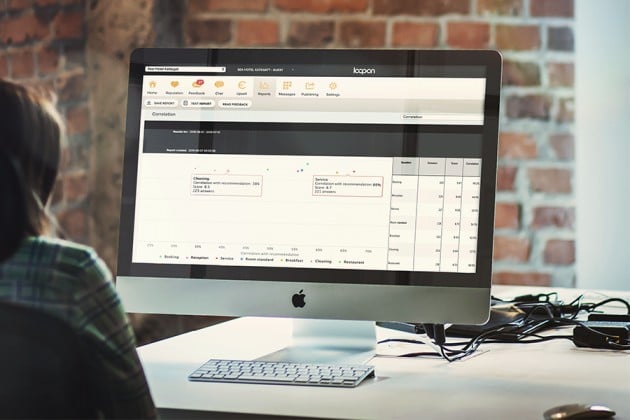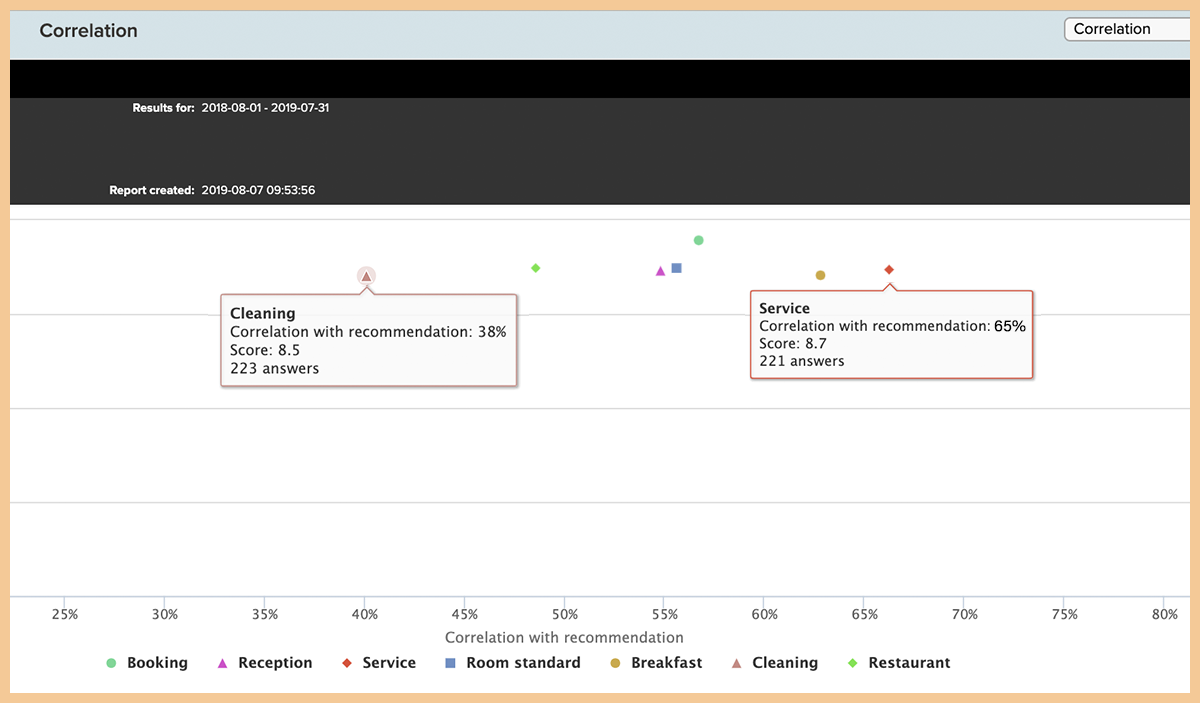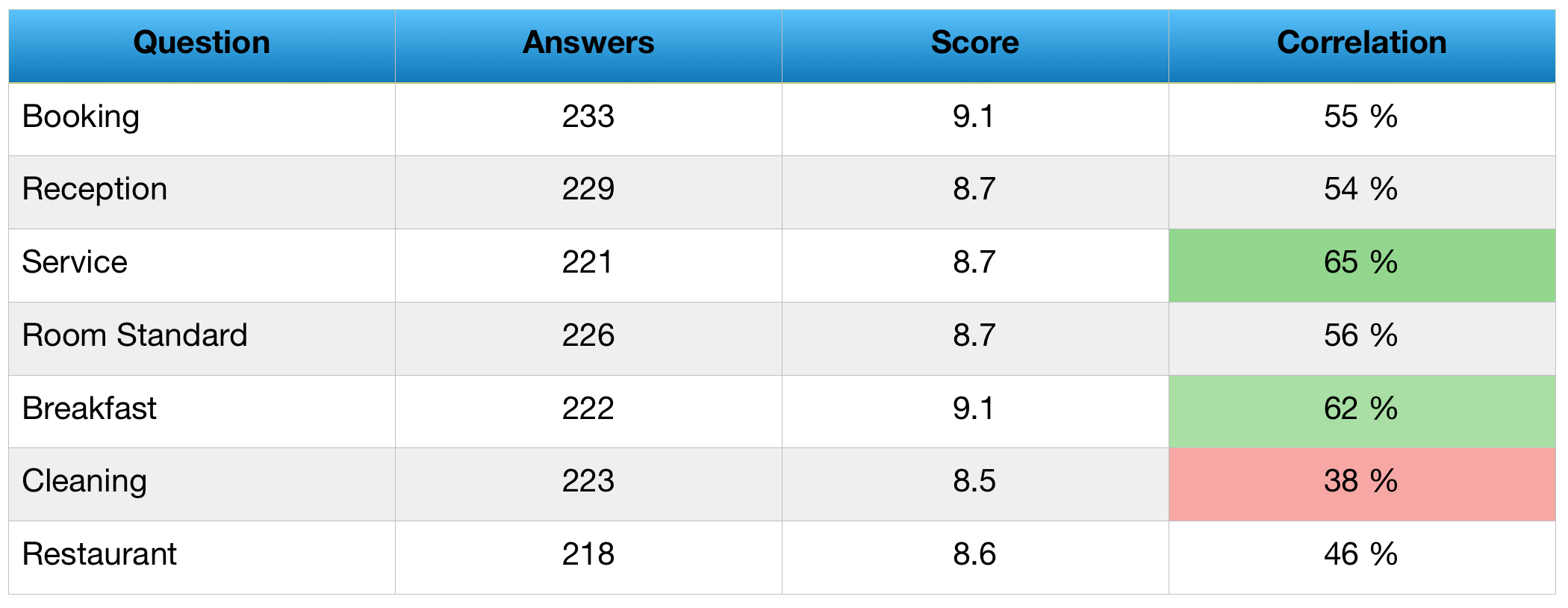
Collecting feedback will go a long way, but actually deep-diving and producing reports will help your hotel understand your guests better. Feedback reports will tell you everything from your NPS® and goal targets to the quality of service or tastiness of the breakfast. One of the most important reports is the Correlation Report as it measures the importance of each variable compared to your NPS®. In our latest blog article we look more closely at the correlation report, how it can be applied and why it should be used with a hint of caution.
About Correlation
Correlation is defined as a statistical technique that can show whether and how strongly pairs of variables are related. The correlation coefficient ranges from -1.0 to +1.0, with -1 indicating that two variables are perfectly negatively correlated (If A increases, B will decrease linearly) while +1 indicates that the two variables are perfectly positively correlated (If A increases, B will increase linearly).
An example of two variables that are correlated could be income and spending. A person earning a higher income is also likely to have higher spending than someone with a minimum wage and vice versa. Of course, these variables are not perfectly correlated but in most instances a person’s spendings will vary to some extent depending on their income.
Applying Correlation to the Hotel World
Correlation can be applied to the hospitality industry in order to determine which variables have the largest impact, positive or negative. Perhaps your hotel is boasting a very impressive 8.5 score on cleaning, something that your hotel takes great pride in. However, is this score actually impacting the guests' overall opinion and their willingness to recommend the hotel? The correlation report will give some sort of indication of how important the variable/department really is to your guests.
As the correlation report below shows, despite the high score of 8.5, cleaning does not have a strong correlation to an increase in NPS® or likeliness to recommend the hotel to friends and colleagues. On the other hand, the service has a 65% correlation with NPS®, indicating that it is a much more important variable for improving the hotel’s NPS®. Correlation reports can be used for multiple different reasons and, although far from perfect, it will give some indications of which variables your guests value the most.

Three reasons why Correlation Reports are Valuable for Hotels
1. Determine where to Allocate your Resources
Is your hotel spending a lot of time, money and human resources on a department that your guests don’t value as much as another department? Maybe guests consider having a great breakfast more valuable and important than a fancy dinner, yet you’re investing 3X as many resources on the restaurant. A correlation report will give hints of where to allocate your resources more effectively in order to improve your online rankings and NPS®.
2. Understand your Guests & Prioritise Marketing Efforts
A correlation report can tell you what your guests really value. Is outstanding service a key factor? The standard of the room? Ease of booking? The correlation report highlights the way your guests think. Back to the breakfast vs restaurant example, if you see a stronger correlation between breakfast and NPS® than restaurant and NPS®, you may want to re-prioritise your marketing efforts. For example, creating a special breakfast upsell offer to highlight your excellent breakfast can lead to additional revenue and higher guest satisfaction, inviting even more guests to the breakfast. Maybe you also want to continue to boast about your breakfast on booking sites and online advertisement in order to increase booking conversion rates. Or you could take a different approach and invest in Marketing your restaurant in Pre-Stay upsell emails where you provide a special discount to drive more people to the restaurant and create a unique, improved experience, attempting to re-vamp the overall restaurant experience.
3. Spot Market Trends
Besides highlighting which variables are most strongly correlated with your NPS®, it can help with spotting market trends. If you see that over time, a variable such as room standard is dropping from 85% to 70% to 55% across two years, it shows that your guests are valuing room standards less and less and instead prioritising other factors. Perhaps service is more important than the previous year or ease of booking is crucial. A correlation report can show the progress of variables over time and highlight key market trends.
Determining if the correlation is significant
A correlation relationship is by no means perfect and is very rarely anywhere close to -1 or +1. Persons who are 185cm tall will on average have a larger shoe size than persons who are 170cm tall, but that doesn't mean that a person who is taller will always have a larger shoe size. The correlation will tell you how much of the variation in people’s shoe size is affected by their height with a higher correlation coefficient indicating a stronger effect. Hotels spending €1000 per day on Marketing would on average bring in more new customers from that channel than hotels spending €100 per day. Again, this doesn't guarantee that a hotel spending more on Marketing will bring in more customers from that Marketing channel. Other variables such as audience, location and price will also affect the outcome of the campaign.
The question often asked is how significant is the correlation? In order to answer that, a Correlation Significance Test can be performed, factoring in sample size. The significance level will tell you how likely it is that the correlations reported are correct versus how likely that they are due to chance or random sampling error, such as sample size. Therefore, performing a correlation analysis over a longer period of time might be better in order to reduce the risk of error for the test.

A Hint of Caution
Don’t make key operational decisions only based on a correlation report. No matter how strong or weak the correlation, it doesn’t always tell the whole story. With the cleaning example, the average score was 8.5 indicating that the majority of guests give the cleaning a very high rating and that standards are extremely high. How strong would the correlation be if the cleaning standards were much lower and receiving a 4.0 rating? Are we sure that the correlation coefficient wouldn’t be much stronger? A drastically lower cleaning score would likely lead to a drop in willingness to recommend the hotel, however this correlation is not spotted as strong due to a high standard of cleaning.
Always try to look at the whole picture, taking each and every variable into account and really understanding why a certain correlation exists. Read feedback on that specific department, why did customers think it was good, how could it be improved? A single report will never tell the full story on its own.
In Summation
Correlation reports can be highly useful for hotels as it will give a quick and easy-to-interpret overview of which variables and which departments have the most impact on NPS® and your guests’ likeliness to recommend your hotel. It can help with determining resource allocation more effectively, understanding your guests and where to prioritise marketing efforts, and spotting market trends. Despite the usefulness of correlation reports, they should be used with a hint of caution and not necessarily be the only deciding factor for making key operations. It’s just as important to dive deeper in order to really understand the why behind the correlation coefficient and understanding the practical importance of the correlation.
